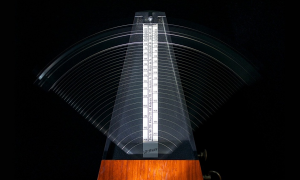Home » Jazz Articles » Drum Addiction » Getting The Hi-Hat Sound
Getting The Hi-Hat Sound
Many drummers play the hi-hat with a heel-down rocking motion, using the foot much in the same way as the bass drum pedal-striking the cymbals together with the forward motion of the "rocking" ball of the foot. While this is an excellent system for a jazz ride feel or "barks," it is very difficult to achieve an accurate consistent "chick" sound.
A technique used by many professionals is the foot "bouncing" method. While slight variations can be used, I will describe the basic technique. As proficiency is achieved, personal adjustments can be made. However, it is important that the basic technique be mastered first because it is the foundation.
To begin, be sure that the heavier cymbal is on the bottom and flat with no tilt. The top cymbal should be attached to the clutch with medium pressure between the felt gaskets. The cymbals should be approximately two to three inches apart.
Place the ball of the foot on the footboard, pressing the cymbals together tightly while keeping the heel up as high as possible. Next, still keeping the cymbals tightly together, the heel should make a full stroke-to the heel plate and back to the "up" position. Do this on each beat counting "1, 2, 3, 4, 1, 2, 3, 4" etc. At first the heel may strike the plate, but eventually should be controlled so as not to hit the plate and make a sound. Continue this until you can comfortably make the full heel strokes while still holding the cymbals together firmly with the ball of the foot.
A tip: Practice with your foot on the floor instead of the hi-hat pedal, keeping pressure on the floor with the ball of the foot. It should never leave the floor while making the heel strokes. The next step is to lift the ball of the foot a split second before making the heel stroke on beat 2, causing the cymbals to open and close very quickly. The foot should "ride" the foot plate, keeping contact at all times. The ball of the foot should also return to its original position just immediately before the heel reaches its lowest point in the stroke. It is almost like a short skip motion. This should produce the desired "chick" sound. When this can be done, the final step is to do the same "skip" on beat 4. Again, practicing this movement on the floor first is very helpful.
With practice, you should get a nice, sharp "chick" sound on beats 2 and 4 while keeping a steady pulse with your heel on all four beats. This technique is invaluable in helping to keep steady time without having to rely on any other part of the drum set. It is useful not only when playing time but also during fills and solos.
Once mastered, work on using the "skip" motion on all four beats, thus keeping a steady pulse. Then vary it for different time signatures: e.g., beat 2 or beats 2 and 3 for 3/4 time; 2 and 4 for 5/4; etc. Eventually, you should be able to play clean, clear straight 8th notes using this hi-hat foot technique.
< Previous
Mette Henriette
Next >
Hidros 6: Knockin'
Comments
Tags
For the Love of Jazz
 All About Jazz has been a pillar of jazz since 1995, championing it as an art form and, more importantly, supporting the musicians who create it. Our enduring commitment has made "AAJ" one of the most culturally important websites of its kind, read by hundreds of thousands of fans, musicians and industry figures every month.
All About Jazz has been a pillar of jazz since 1995, championing it as an art form and, more importantly, supporting the musicians who create it. Our enduring commitment has made "AAJ" one of the most culturally important websites of its kind, read by hundreds of thousands of fans, musicians and industry figures every month.



















